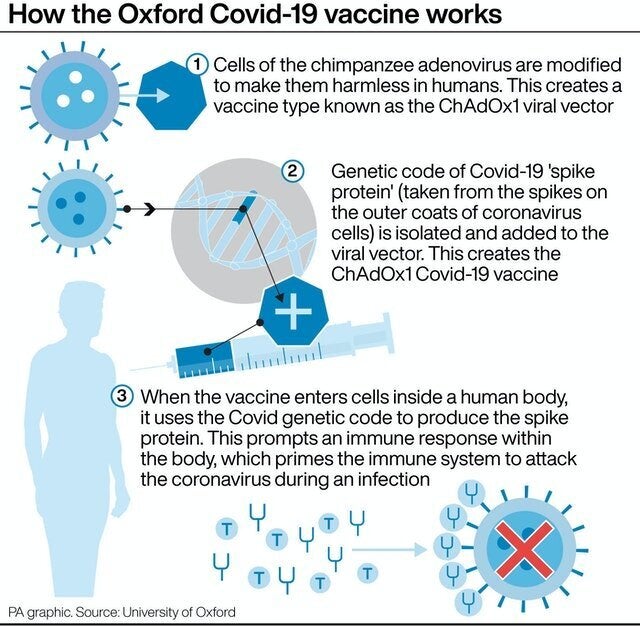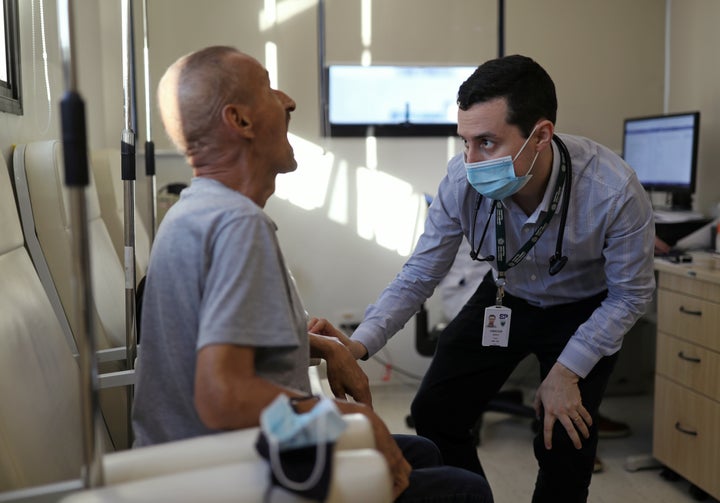A potential Covid-19 vaccine developed by AstraZeneca Plc and Oxford University has been shown to be 70.4% effective, it has been announced.
The jab is effective in preventing many people getting ill and it has been shown to work in different age groups, including the elderly.
And one of the dosing patterns used by the scientists suggested 90% effectiveness if one half dose is given followed by a further full dose.
Here’s what we know about how it works:
How does the AstraZeneca/Oxford vaccine work?
The vaccine – called ChAdOx1 nCoV-19 – uses a harmless, weakened version of a common virus which causes a cold in chimpanzees.
Researchers have already used this technology to produce vaccines against a number of pathogens including flu, Zika and Middle East respiratory syndrome (Mers).
The virus is genetically modified so it is impossible for it to grow in humans, PA Media reports.

Scientists have transferred the genetic instructions for coronavirus’s specific “spike protein” – which it needs to invade cells – to the vaccine.
When the vaccine enters cells inside the body, it uses this genetic code to produce the surface spike protein of the coronavirus.
This induces an immune response, priming the immune system to attack coronavirus if it infects the body.
What about these different dosing patterns?
The top line figure of 70% effectiveness is an average of two different dosing regimens used in the trials.
When one full dose was followed by another full dose, it gave 62% efficacy.
But when only half a dose was given followed by a full dose, a much higher 90% effectiveness was achieved.
The combined analysis from both dosing regimens resulted in an average efficacy of 70.4%.
It’s not yet been confirmed why the half dose regimen gave better results, but it could have to do with the way in which different levels of the vaccine prime the immune system.
Professor Andrew Pollard, chief investigator of the Oxford Vaccine Trial at Oxford, said: “These findings show that we have an effective vaccine that will save many lives.
“Excitingly, we’ve found that one of our dosing regimens may be around 90% effective and, if this dosing regime is used, more people could be vaccinated with planned vaccine supply.”

Does it differ to Pfizer and Moderna’s vaccines?
Yes. The jabs from Pfizer and Moderna are messenger RNA (mRNA) vaccines.
Conventional vaccines are produced using weakened forms of the virus, but mRNAs use only the virus’s genetic code.
An mRNA vaccine is injected into the body where it enters cells and tells them to create antigens.
These antigens are recognised by the immune system and prepare it to fight coronavirus.
No virus is needed to create an mRNA vaccine. This means the rate at which the vaccine can be produced is accelerated.
What are the implications for developing countries?
Prof Pollard, the head of Oxford trial team, said the vaccine is being developed for distribution “everywhere” including places with limited infrastructure for the ultra-cold storage that some vaccines require.
The mRNA vaccines such as those made by Pfizer and Moderna will likely require being stored at extremely cold temperatures, around -70C.
This throws up a number of logistical challenges when considering how they will be transported en masse over long distances and to hotter parts of the world.
Because the protein-based Oxford vaccine will only require refrigerating at around 2C-8C, it will be far easier to transport and store worldwide.
Speaking on BBC Radio 4’s Today programme earlier this month, Prof Pollard said: “We’re really looking globally, we want to be able to get to every corner of the world if indeed the vaccine is shown to work.
“The thing that matters with vaccines is the impact it can have, and that is, can you get it to people and are they being vaccinated, so until you’ve got high coverage and you’re able to prevent the disease in those who are most vulnerable, we won’t get there.”
The United Nations Children’s Fund (UNICEF) has already begun a huge operation to have 520 million syringes stored in its warehouses across the globe by the end of the year, ready and waiting for the roll out of a safe vaccine.
But there are concerns poorer countries could be priced out of the Oxford vaccine in the future.
Moderna has already said it will profit from a successful vaccine while Pfizer said in the summer the company will “price our potential vaccine consistent with the urgent global health emergency that we’re facing”.
They added: “A vaccine is meaningless if people are unable to afford it.”
What about antibodies and T-cells?
The Pfizer, AstraZeneca and Moderna vaccines have been shown to provoke both an antibody and T-cell response.
Antibodies are proteins that bind to the body’s foreign invaders and tell the immune system it needs to take action.
T-cells are a type of white blood cell which hunt down infected cells in the body and destroy them.
Nearly all effective vaccines induce both responses.
The Oxford vaccine induces robust antibody and T-cell responses across people of all ages, the data indicates.
Can the Oxford vaccine be manufactured to scale?
Yes. The UK government has secured 100 million doses as part of its contract, enough for most of the population.
The head of the UK Vaccine Taskforce, Kate Bingham, has said she is confident it can be produced at scale.
Experts hope the jab could be ready to go and rolled out shortly.
Can this vaccine help the elderly?
There have been concerns that a Covid-19 vaccine will not work as well on elderly people, much like the annual flu jab.
However, data from the Oxford-AstraZeneca trial suggests there have been “similar” immune responses among younger and older adults.
The results show that the vaccine is better tolerated in older people compared with younger adults, and produces a similar immune response in old and young adults.
